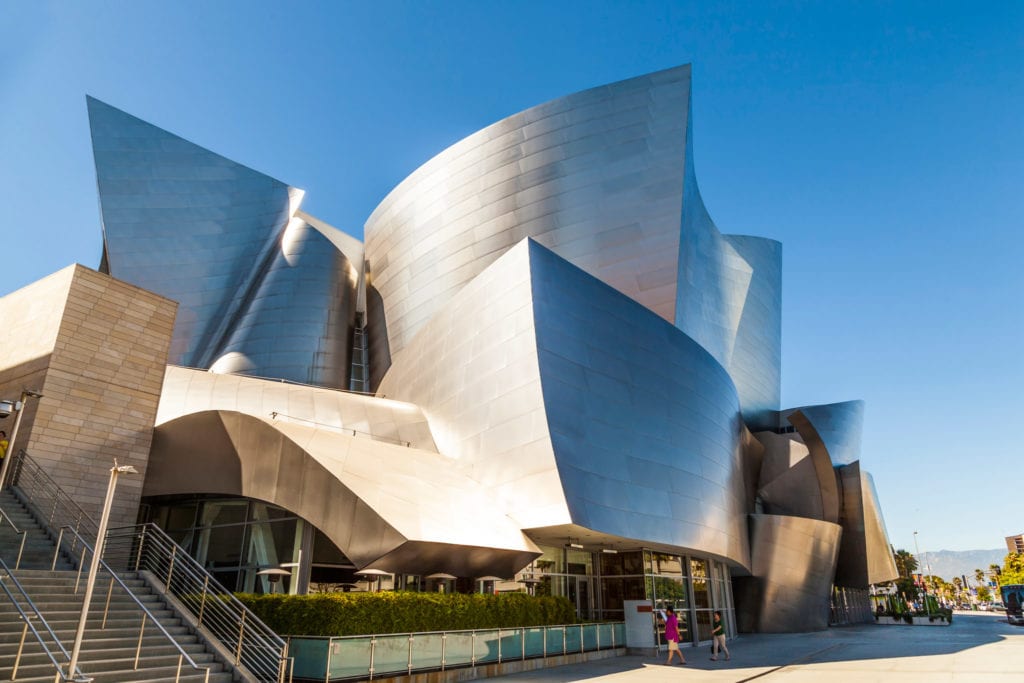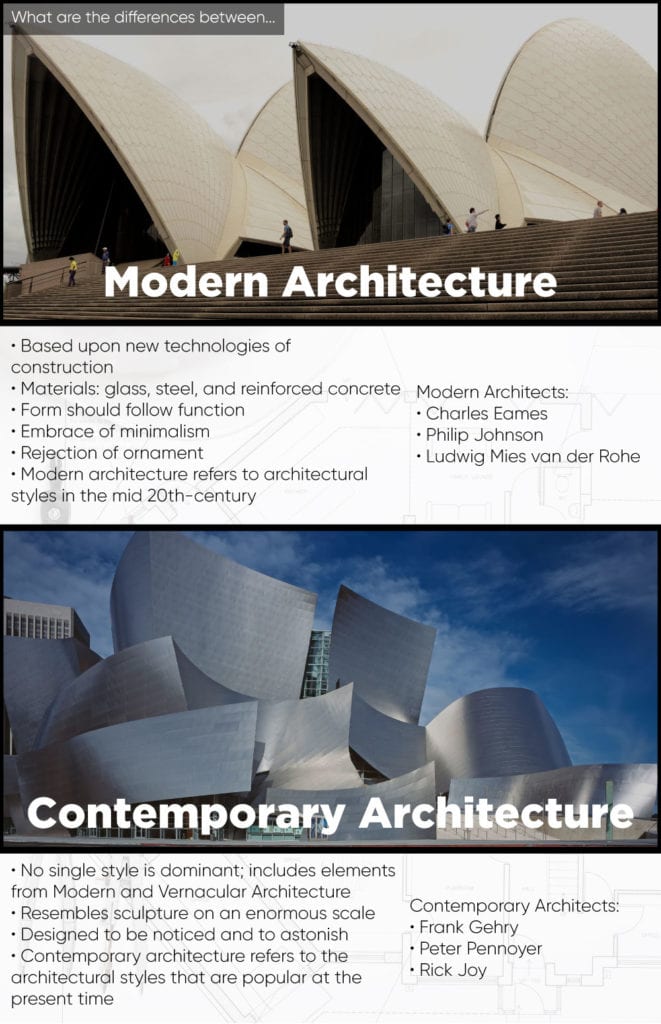Contemporary Architecture Basics
Have you followed the new trends that have taken contemporary architecture by storm? Contemporary architects produce some of today’s most famous building styles. That includes single-family homes and downtown office buildings that are incorporating contemporary styles.
Most of these buildings still reflect classic architecture features. They incorporate these and give them a new modern turn. It is challenging to describe contemporary architecture with conclusive features. Even given this fact, we can attempt to describe buildings that fit this classification.
Contemporary architecture is widespread across the world. It is not only common in Europe and the United States. With time, contemporary design will become a thoroughly global affair. This is the opposite of modern architecture, which was more restricted to Europe and the United States. Now, you can also find this type of famous building worldwide. They are in countries such as China, Latin America, Australia, and Canada, among others.
What is Contemporary Architecture?
Contemporary architecture is the movement where modern styles blend, sharing various features. And these styles rely on fewer classicized building ideas. The term ‘contemporary’ may have been misplaced. This is because it can still describe buildings that are almost eight decades old. Your home or office may be contemporarily designed. It means you reside in one of the pioneers of new building styles. Because there are many styles, it is difficult to come up with a formal definition to describe the movement.
Traditional architectural styles play a massive role in beautifying corporate offices. They also bring functionality to the corporate environment. For this reason, most architects still pay tribute to classicized features. They can do this in as a sign of loyalty to architectural legacy as well as for form and function. The style differentiates itself from the modern architecture of the late twentieth century. This is due to adding eco-friendly features and introducing all manners of creativity. Moreover, it involves the use of state-of-the-art technology and materials. Today, it is easy to simulate computer-aided designs to create buildings. With modern computer software, architects can design with high-level precision and speed.
Features of Contemporary Architecture: The Expressiveness of Form and Design
Classicized ideas thrived on specific design elements. The have flourishes that are predictable and distinguishable while contemporary architecture is more flexible. Contemporary architects thrive on sophisticated and innovative ideas. They deviate from traditions and norms. To achieve this, they need contemporary materials to create these ideas. You will not only appreciate the innovative and creative designs in these buildings. You will also understand the aesthetic feeling through the unique design of structures.
Moreover, contemporary architecture uses a vast range of building materials. These include concrete, glass, wood, and aluminum screens. These materials add contrast and homogeneity. For instance, you will notice they have oversized plate glass windows. These allow plenty of natural light and create large open spaces. They engender a sense of airiness, hence minimizing air conditioning costs. Moreover, the building frames follow symmetry and they often have innovative shapes. To know that some of these materials are eco-friendly is a huge bonus for this style.
Reinforced Concrete Advances
In the past, many considered the use of concrete as brutal. However, modern architecture realized the value of reinforced concrete. With this material, architects can create contemporary designs. Also, you can mold reinforced concrete into almost any shape imaginable. With it, you can create visually-appealing buildings while being budget-friendly. Once you reinforce it with materials like steel, it can be erected in ways hard to find in other buildings. You can texturize it with recyclable materials to add sophistication to it. Recycled glass is one such material. Omitting the use of concrete is next to impossible.
Aside from materials, this form of art has made itself distinct in other ways. Also, contemporary architecture takes advantage of curved lines and rounded spaces. These create a visually appealing structure. It frequently uses these instead of straight lines. This explains why clean lines are catchphrases of this form. Unambiguous elements of minimalism are often linked to modern architecture. Contemporary designs also imitate minimalist movements. This means that we still use classicized models in works of art. They are in both modern and contemporary structures.
The Sense of Sustainability
The present is an era where global warming is a real issue. It is now essential to take specific measures to ensure nature is not compromised. For this reason, modern architects design buildings that are energy efficient. This is in part thanks to recycled materials for the construction process. This needs to include the use of solar panels for roofing purposes. Moreover, the widespread use of reinforced concrete creates not only innovative ideas. It also enhances aesthetic appeal to most buildings. These architects hope to achieve this idea. They’d want to do this to ensure that the whole project is economical. They also want to focus on sustaining the end user’s needs.
Classicized Borrowed Ideas
Modern building techniques borrow ideas from classicized styles. Without those, it would not have advanced as an art as far as it has. Moreover, most elements rely on ideas from the early to the mid-20th century. With clean lines and neatness, contemporary architecture demonstrates a free-flowing form of creativity. Most countries in Europe, Latin America, and Asia, among others, have adopted this form. It portrays a lot of curvilinear styles to ease movement. It is no wonder that limestone, glass, and titanium bring out essential elements. These are elements such as natural light, eco-friendly materials, and creative styles.
Architects dealing in contemporary architecture use computer-aided software. It makes it easier to create sophisticated curves and shapes of most buildings. Take a look at the Guggenheim Museum in Bilbao, Spain built back in 1997. Frank Gehry did a fantastic job thanks to computer-aided design systems. He is a firm believer of open tracks of landscapes combining natural features to break from the norm.
Flat and Overhanging Roofs
The old form of roofing was also limited to pitched triangular designs at the top. It is most associated with American buildings. But the new trend has invited the idea of flat overhanging roofs. This creates more shade. It does this while protecting your building from unnecessary elements. These roofs also project architecture into the outdoors, providing cohesiveness. You will have more reasons to enjoy outdoor spaces. This is thanks to the overhang that presents an awning experience.
Nature-Compliant Designs
Contemporary architecture is also in harmony with nature and structure. Classic designs positioned the windows in the center of walls and used them to view outside. In contrast, contemporary designs use large panels of glass to allow in natural light. Moreover, passive solar heating generated comfort and openness even during winter. It is hard to start imagining the impact of clerestory windows and skylights. These elements are higher than head level. They offer light from the outside world.
Eco-housing forms one of the most critical elements of environment-focused contemporary architecture. When architects use natural materials and building styles, they look to nature for inspiration. Also, they ensure it will not have a negative impact on living creatures. Better still, the designs complement and harmonize the natural environment. They create seamless accountability. This explains why most of the buildings are created in such a way that consciously makes them part of the environment.
Contemporary Architecture Summed Up
The exit of classicized styles of building and construction also matters. Contemporary architecture has taken its place. There’s a new shift of contemporary designs. It is almost impossible to give a precise definition of what it involves. This work of art relies on stark, clean lines. Also, the utility factor of modern architecture presents along with personalized design structures. That said, specific procedures, design values, and even materials define it. These factors can identify and describe the work.
Contemporary architecture relies on eco-friendly features. It embraces all types of innovations. These bring new meaning to modern building and construction. Moreover, it uses the latest technology and recyclable materials. It creates buildings that are high-tech and durable. And they are taller than most of their predecessors. If the trend continues, people will drive to live and work in contemporary architecture structures that respect the law of nature.






